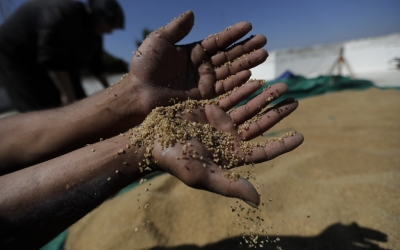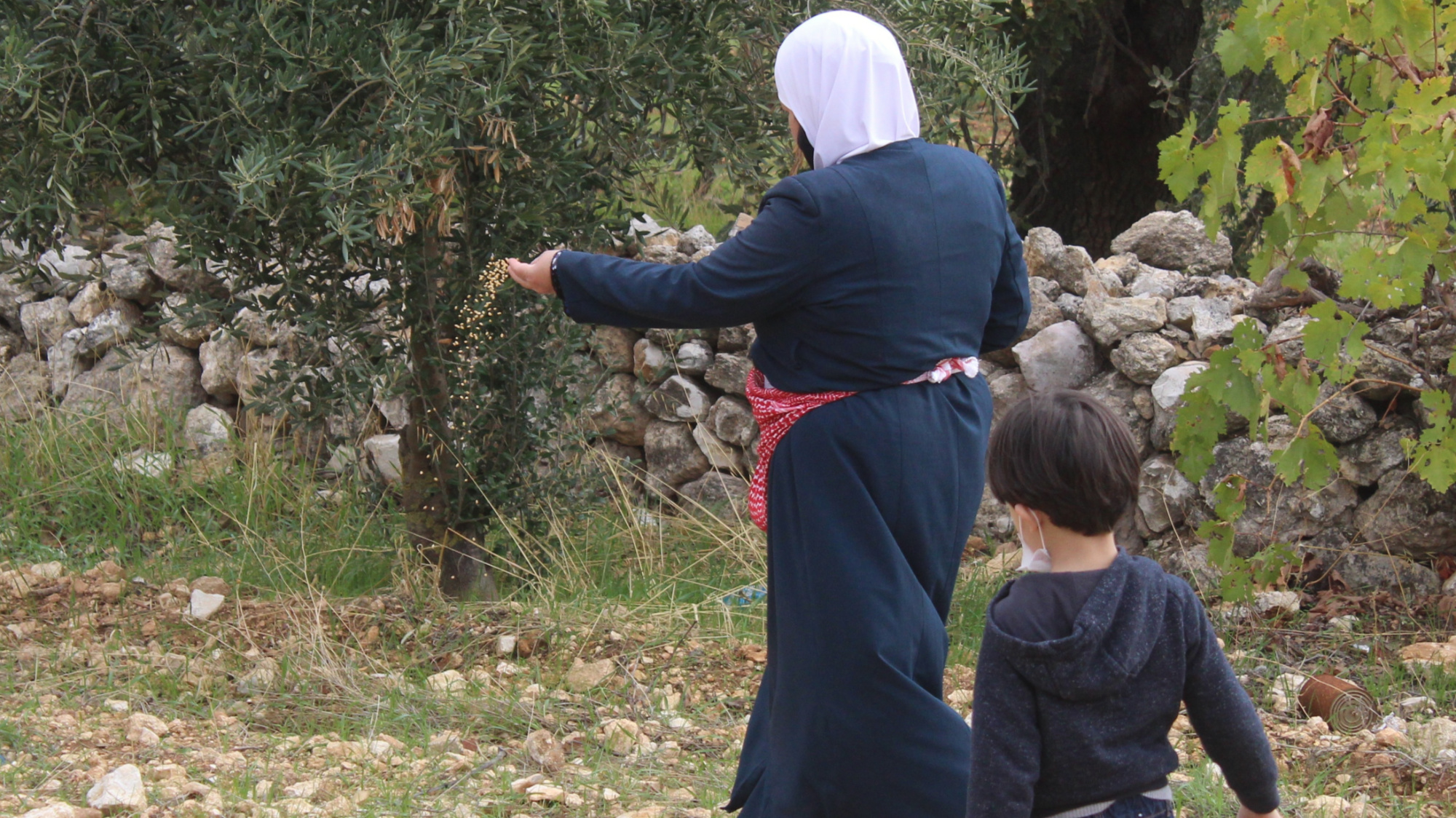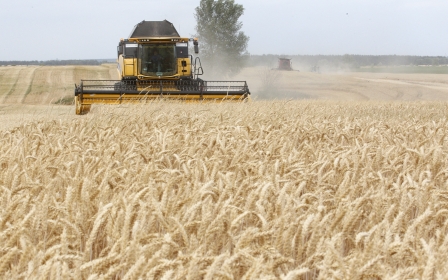Russia-Ukraine war: Calls for Middle East food sovereignty amid looming wheat crisis

Concerns are growing across the Middle East that the war in Ukraine will cut off international shipments of wheat, spurring shortages and soaring prices of a staple food millions of people rely heavily upon.
Russia and Ukraine produce about a quarter of the world’s wheat. The MENA region is particularly dependent on wheat imports from Black Sea ports, which have halted shipping since Russia’s invasion of Ukraine.
In Egypt, where bread is known as aish, meaning "life”, prices are rising dramatically. The country is the world’s top wheat importer, with nearly 70 percent of its wheat coming from Russia and Ukraine in 2019, according to the Observatory of Economic Complexity (OEC).
Lebanon imports 52 percent of its wheat from Russia. As a result of the devastating blast in August 2020 that destroyed Beirut’s grain silos, the country’s infrastructure can only hold about one month’s supply of wheat.
More than a third of Yemen’s wheat comes from the Black Sea region. Ravaged by years of war that have pushed millions to the brink of famine, Yemen is highly dependent on bread, a staple that makes up over half of the calorie intake for the average household. Disruptions to wheat supplies could worsen the hunger crisis.
Prices of wheat were already rising globally as a result of pandemic-related shipping disruptions, rising costs for farmers and adverse weather. The United Nations’ World Food Programme warned that war in Ukraine could drive millions of people in the Middle East into food poverty and lead to food insecurity globally.
But for some, the impending wheat crisis is a reminder that local production of food should be a priority for the region’s social, economic and political security.
Lots of potential
“Our dependence on imports makes us susceptible to all sorts of crises,” says Mariam Al Jaajaa, a member of the Arab Network for Food Sovereignty (ANFS), a group of civil society organisations from 13 different Arab countries that has been advocating for investment in domestic production of food in the region since it was established in 2012.
“The cultivation of food staples like wheat should be promoted to improve our food security, and it should be prioritised over crops intended for export,” says Jaajaa.
'We don’t have sovereignty over our decisions, we have foreign actors and global institutions imposing policies'
- Mariam Al Jaajaa, Arab Network for Food Sovereignty
The Middle East is increasingly impacted by extreme temperatures and water stress, which affect the region’s ability to feed one of the world’s fastest-growing populations. But for Jaajaa, who manages the non-profit Arab Group for the Protection of Nature (APN), the main challenge is the region’s loss of sovereignty over land, food and resources.
“We don’t have sovereignty over our decisions, we have foreign actors and global institutions imposing policies,” she says. “Arable lands in the region are estimated at around 200m hectares, but only about 30 percent is cultivated. Our agricultural sector has been marginalised, and large plots of fertile lands are not protected.”
There is a lot of potential to improve water and land management, and increase agricultural production.
“We need to invest in resilient local food systems and also in a regional strategy for food security,” she says.
Between 2007 and 2010, wheat prices soared because of a combination of drought in grain-producing countries, rising oil prices and financial speculation. The food crisis sparked protests and food riots across the world, and is regarded as one of the triggers of the Arab Spring uprisings.
Bread is more than a vital source of calories that many rely on to avoid starvation. Protesters often carry loaves of bread as a symbol of livelihoods and dignity. When a piece of bread falls to the ground, it is picked up, pressed to the forehead and kissed in reverence, a ritual some trace back to the Roman period.
The Fertile Crescent - spanning from modern-day northern Egypt to Iraq - was where wheat was first domesticated, more than 10,000 years ago. For millennia, the Middle East was a major producer of rain-fed wheat, the population’s main source of food.
Yet today, the region that saw the birth of agriculture has become one of the world’s largest importers of food.
Demise of local food production
For Rami Zurayk, professor at the Faculty of Agricultural and Food Sciences at the American University of Beirut, the demise of local food production can be traced back to the integration of the Arab region in global markets.
In the first half of the 20th century, many countries in the region were still producing their own wheat. But over decades, imports of food started increasing exponentially, as policies shifted from self-sufficiency of staples to the cultivation of profitable crops for export.
“Agriculture became a capitalist enterprise, rather than a social, cultural, economic project,” says Zurayk.
“It is no longer connected to local consumption but to global markets. Farmers are encouraged to produce marketable goods. The production of food is not aimed at addressing the needs of the local population but at satisfying the production and accumulation of wealth that benefits only a few.”
Even though agriculture employed more than half of the working population in the 1970s, most countries in the region allocated less than 10 percent of all expenditure to the sector, and did little to prevent the loss of agricultural land as concrete blocks replaced wheat fields. Population growth expanded wheat consumption, but production levels dropped.
'Agriculture became a capitalist enterprise, rather than a social, cultural, economic project'
- Rami Zurayk, American University of Beirut
The failure to improve local productivity was followed by the adoption of liberalisation policies and cuts in public spending in the 1980s. Under pressure from trade agreements and the International Monetary Fund (IMF)’s structural adjustments, export-oriented production was prioritised and agricultural subsidies were removed.
“With little investment in local food production and increasing reliance on global trade, we started importing cheaper white refined flour instead of growing local wheat,” says Zurayk.
Unable to compete with the industrialised wheat that flooded local markets, farmers turned to more profitable crops such as fruits and vegetables, or abandoned their lands and moved to rapidly growing urban areas.
“We are seeing a disappearance of people’s connection to nature and food production,” Zurayk tells MEE.
Imagining alternatives
In Jordan, a grassroots initiative is trying to reshape these connections by converting unused land into wheat fields.
Al-Barakeh Wheat - which means “blessing” - took off in late 2019, when Lama Khatieb and Rabee Zureikat decided to grow their own wheat.
After their first wheat harvest in a time of pandemic restrictions and disruptions in supply chains, they started locating empty plots of land in Amman, Jordan, and mobilising their community to take part in collective farming.
In addition to teaching participants to grow their own wheat and become more self-sufficient, the initiative is also connecting small-scale farmers to alternative markets to show that growing local wheat can be economically feasible.
“The power of Al-Barakeh lies in people’s ability to reproduce it in their own communities, and in the ability to imagine an alternative to the current system,” says Khatieb.
For Khatieb and Zureikat, reviving local wheat is a way of encouraging more people to grow their own food and to promote sovereignty in a region that relies heavily on food imports.
But above all, the initiative is about reclaiming agency, independence and dignity.
Middle East Eye delivers independent and unrivalled coverage and analysis of the Middle East, North Africa and beyond. To learn more about republishing this content and the associated fees, please fill out this form. More about MEE can be found here.







